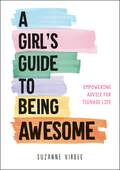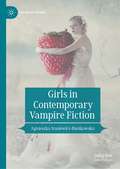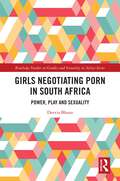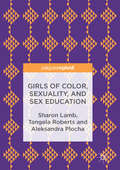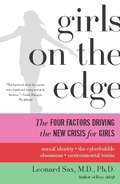- Table View
- List View
A Girl's Guide to Being Awesome: Empowering Advice for Teenage Life
by Suzanne VirdeeLet’s face it: growing up is confusing. This book is here to act as your go-to guide on everything from social media to sexting and from body image to self-esteem. Acting as your personal cheerleader, this book will teach you everything you need to navigate your teens with sass and style.
Girls’ Identities and Experiences of Oppression in Schools: Resilience, Resistance, and Transformation
by Britney G. Brinkman Kandie Brinkman Deanna HamiltonThis book uses an intersectional approach to explore the ways in which girls and adults in school systems hold multiple realities, negotiate tensions, cultivate hope and resilience, resist oppression, and envision transformation. Rooted in the voices and lived experiences of girls and educators, Brinkman, Brinkman and Hamilton document girl-led activism within and outside schools, and explore how adults working with girls can help contribute toward them thriving. Girls’ narratives are considered through an intersectionality framework, in which gender identity, race, ethnicity, social class, sexual orientation, and other aspects of social identity intersect to inform girls' lived experiences. Exploring data and interviews collected over a 15-year period, the authors set out a three-part structure to outline how girls engage in strategies to enact resilience, resistance, and transformation. Part one reconceptualizes traditional definitions of resilience and documents girls’ experiences of oppression within schools, identifying common stereotypes about girls and examining the complexity of girls’ "choices" within systems that they do not feel they can change. Part two highlights girls’ active resistance to stereotypes, pressures to conform, and interpersonal and systemic discrimination, from entitlement of their boy peers to experiences of sexualization in school. Part three illuminates pathways for educational transformation, creating new possibilities for educational practices. Offering a range of pedagogies, policies, and practices educators can adopt to engage in systemic change, this is fascinating reading for professionals such as educators, counsellors, social workers, and policy makers, as well as academics and students in social, developmental, and educational psychology.
Girls’ Identities and Experiences of Oppression in Schools: Resilience, Resistance, and Transformation
by Britney G. Brinkman Kandie Brinkman Deanna HamiltonThis book uses an intersectional approach to explore the ways in which girls and adults in school systems hold multiple realities, negotiate tensions, cultivate hope and resilience, resist oppression, and envision transformation. Rooted in the voices and lived experiences of girls and educators, Brinkman, Brinkman and Hamilton document girl-led activism within and outside schools, and explore how adults working with girls can help contribute toward them thriving. Girls’ narratives are considered through an intersectionality framework, in which gender identity, race, ethnicity, social class, sexual orientation, and other aspects of social identity intersect to inform girls' lived experiences. Exploring data and interviews collected over a 15-year period, the authors set out a three-part structure to outline how girls engage in strategies to enact resilience, resistance, and transformation. Part one reconceptualizes traditional definitions of resilience and documents girls’ experiences of oppression within schools, identifying common stereotypes about girls and examining the complexity of girls’ "choices" within systems that they do not feel they can change. Part two highlights girls’ active resistance to stereotypes, pressures to conform, and interpersonal and systemic discrimination, from entitlement of their boy peers to experiences of sexualization in school. Part three illuminates pathways for educational transformation, creating new possibilities for educational practices. Offering a range of pedagogies, policies, and practices educators can adopt to engage in systemic change, this is fascinating reading for professionals such as educators, counsellors, social workers, and policy makers, as well as academics and students in social, developmental, and educational psychology.
Girls in Contemporary Vampire Fiction (Palgrave Gothic)
by Agnieszka Stasiewicz-BieńkowskaThis book explores the narratives of girlhood in contemporary YA vampire fiction, bringing into the spotlight the genre’s radical, ambivalent, and contradictory visions of young femininity. Agnieszka Stasiewicz-Bieńkowska considers less-explored popular vampire series for girls, particularly those by P.C. and Kristin Cast and Richelle Mead, tracing the ways in which they engage in larger cultural conversations on girlhood in the Western world. Mapping the interactions between girl and vampire corporealities, delving into the unconventional tales of vampire romance and girl sexual expressions, examining the narratives of women and violence, and venturing into the uncanny vampire classroom to unmask its critique of present-day schooling, the volume offers a new perspective on the vampire genre and an engaging insight into the complexities of growing up a girl.
Girls in Global Development: Figurations of Gendered Power (Transnational Girlhoods #6)
by Heather Switzer, Karishma Desai, and Emily BentMany scholars have critiqued the neocolonial assumptions embedded in global development agendas. These often focus on the bodies and lives of poor, racialized adolescent girls in the global south as ideal sites for intervention based on these girls’ potential to multiply investment, interrupt intergenerational poverty, and predict economic growth. Girls in Global Development presents case studies from established and emerging scholars to collectively theorize and examine the concept of “Girls in Development” (GID), a distinctive way of approaching notions of girls and girlhoods in locations around the globe, at various points in history, through a critical feminist lens.
Girls in Global Development: Figurations of Gendered Power (Transnational Girlhoods #6)
by Heather Switzer Karishma Desai Emily BentMany scholars have critiqued the neocolonial assumptions embedded in global development agendas. These often focus on the bodies and lives of poor, racialized adolescent girls in the global south as ideal sites for intervention based on these girls’ potential to multiply investment, interrupt intergenerational poverty, and predict economic growth. Girls in Global Development presents case studies from established and emerging scholars to collectively theorize and examine the concept of “Girls in Development” (GID), a distinctive way of approaching notions of girls and girlhoods in locations around the globe, at various points in history, through a critical feminist lens.
Girls in Global Development: Figurations of Gendered Power (Transnational Girlhoods #6)
Many scholars have critiqued the neocolonial assumptions embedded in global development agendas. These often focus on the bodies and lives of poor, racialized adolescent girls in the global south as ideal sites for intervention based on these girls’ potential to multiply investment, interrupt intergenerational poverty, and predict economic growth. Girls in Global Development presents case studies from established and emerging scholars to collectively theorize and examine the concept of “Girls in Development” (GID), a distinctive way of approaching notions of girls and girlhoods in locations around the globe, at various points in history, through a critical feminist lens.
The Girls in the Wild Fig Tree: How One Girl Fought to Save Herself, Her Sister and Thousands of Girls Worldwide
by Nice Leng'eteAn inspirational story of one girl who changed the minds of her elders, reformed traditions from the inside, and is creating a better future for girls and women throughout AfricaBorn in a remote village in Kenya, Nice Leng'ete saw the young girls she grew up with receive the cut, the rite of passage into female adulthood in Masai culture. Every girl got the cut, and once you did, you'd be married off to a man triple your age. You might be his second or third wife. You'd have children in your teens.This is exactly what happened to Nice's sister. To resist the cut meant becoming an outcast in Masai culture. Yet Nice managed to avoid it and stay in school. It was not an easy time. She was shunned. At the age of 21, Nice moved to Nairobi to work for Amref Health Africa, an organization spearheading the campaign against Female Genital Mutilation. Though she was still considered an outcast in her village - even an entapai (someone who brought shame to her family) - young girls began to look up to Nice. They saw the life they could have, not the one chosen for them.Eventually, thanks to a combination of incredible instincts, excellent training and leading by example, Nice Leng'ete developed a platform for convincing women across Africa to forego the cut. First, she won over her village elders. It spread from there. Kenya outlawed the cut in 2011, and the Masai people abandoned it in 2014.To date, Nice and Amref Health Africa have collaborated to help more than 16,000 girls avoid FGM in Kenya and Tanzania.
Girls Like This, Boys Like That: The Reproduction of Gender in Contemporary Youth Cultures
by Victoria CannWhat role does taste play in contemporary youth culture? How do young people reproduce, or alternatively, reject gender norms? Using new research and the work of renowned theorists such as Judith Butler and Pierre Bourdieu, Victoria Cann argues that popular culture affects young people's experiences of masculinity and femininity and forces them to navigate a social minefield in which they are pressured to display tastes deemed appropriate for their gender. Combining her own unique empirical research with a strong theoretical framework, Cann widens and links the fields of gender and taste studies to show the everyday reality of twenty-first-century youth and their apprehensions - especially those of young boys- about participating in activities, or embracing pop-cultural preferences that have traditionally only been associated with the opposite sex.
Girls' Literacy Experiences In and Out of School: Learning and Composing Gendered Identities
by Elaine O'QuinnHow do American girls compose and amend their identities? In this text, prominent scholars in their respective fields examine the complex social and cultural constructions that shape girls’ lives both in and out of school. The book looks at matters ranging from embedded issues of class, race, ethnicity, immigrant status, and sexuality to popular culture and personal histories. Exploring the scholarly literature on gender and education, the successes and failures of feminist pedagogy, and girls’ practices with both traditional and non-traditional texts, as well as the primary sources of a material culture, the authors expose the myriad forces that script girls’ gender, identity, and literacy. The distinctive contribution of this book is to open up new discussions of girls in American classrooms today and to critically examine their experiences as they navigate preconceived notions of who they are while forming their personal and public identities, thereby helping teachers to better understand and create classroom experiences that make girls visible to themselves and to others.
Girls' Literacy Experiences In and Out of School: Learning and Composing Gendered Identities
by Elaine J. O’QuinnHow do American girls compose and amend their identities? In this text, prominent scholars in their respective fields examine the complex social and cultural constructions that shape girls’ lives both in and out of school. The book looks at matters ranging from embedded issues of class, race, ethnicity, immigrant status, and sexuality to popular culture and personal histories. Exploring the scholarly literature on gender and education, the successes and failures of feminist pedagogy, and girls’ practices with both traditional and non-traditional texts, as well as the primary sources of a material culture, the authors expose the myriad forces that script girls’ gender, identity, and literacy. The distinctive contribution of this book is to open up new discussions of girls in American classrooms today and to critically examine their experiences as they navigate preconceived notions of who they are while forming their personal and public identities, thereby helping teachers to better understand and create classroom experiences that make girls visible to themselves and to others.
Girls Make Media
by Mary Celeste KearneyMore girls are producing media today than at any other point in U.S. history, and they are creating media texts in virtually every format currently possible--magazines, films, musical recordings, and websites. Girls Make Media explores how young female media producers have reclaimed and reconfigured girlhood as a site for radical social, cultural, and political agency. Central to the book is an analysis of Riot Grrrl--a 1990s feminist youth movement from a fusion of punk rock and gender theory-and the girl power movement it inspired. The author also looks at the rise of girls-only media education programs, and the creation of girls' studies.This book will be essential reading for anyone seeking to understand contemporary female youth in today's media culture.
Girls Make Media
by Mary Celeste KearneyMore girls are producing media today than at any other point in U.S. history, and they are creating media texts in virtually every format currently possible--magazines, films, musical recordings, and websites. Girls Make Media explores how young female media producers have reclaimed and reconfigured girlhood as a site for radical social, cultural, and political agency. Central to the book is an analysis of Riot Grrrl--a 1990s feminist youth movement from a fusion of punk rock and gender theory-and the girl power movement it inspired. The author also looks at the rise of girls-only media education programs, and the creation of girls' studies.This book will be essential reading for anyone seeking to understand contemporary female youth in today's media culture.
Girls, Moral Panic and News Media: Troublesome Bodies (Routledge Research in Gender, Sexuality, and Media)
by Sharon R. MazzarellaMazzarella examines the representational politics behind journalistic constructions of US girls and girlhood through a series of contemporary in-depth case studies which work to document a wider cultural moral panic about the troublesome nature of girls’ bodies. The public concern and media fascination with youth so evident in the United States today is a century-old phenomenon. From the flappers of the 1920s to the bobbysoxers of the 1950s, from the hippies of the 1960s and on to the ever-present pregnant teens, this fascination has played out in the media and has consistently focused on (primarily White, middle-class, heterosexual) girls. A growing body of research has revealed the manner in which journalistic practice constructs such girls as problems. Girls, Moral Panic, and News Media takes a broad look at U.S. news media constructions of girls, girlhoods, and girl’s bodies/sexualities through a series of contemporary in-depth case studies including news coverage of the 2008 Gloucester (MA) High School "pregnancy pact," teen gun control activist Emma González, and the sexualization of "early puberty." In general, the news media constructs girls’ bodies as troublesome and in need of adult surveillance and policing. These case studies document a cultural obsession with girls’ bodies—an obsession that often approaches moral panic. This book will be key reading for researchers and instructors in the rapidly growing international and interdisciplinary field of Girls’ Studies, and scholars of Media Studies, Cultural Studies, Gender Studies, Communication and Journalism.
Girls, Moral Panic and News Media: Troublesome Bodies (Routledge Research in Gender, Sexuality, and Media)
by Sharon R. MazzarellaMazzarella examines the representational politics behind journalistic constructions of US girls and girlhood through a series of contemporary in-depth case studies which work to document a wider cultural moral panic about the troublesome nature of girls’ bodies. The public concern and media fascination with youth so evident in the United States today is a century-old phenomenon. From the flappers of the 1920s to the bobbysoxers of the 1950s, from the hippies of the 1960s and on to the ever-present pregnant teens, this fascination has played out in the media and has consistently focused on (primarily White, middle-class, heterosexual) girls. A growing body of research has revealed the manner in which journalistic practice constructs such girls as problems. Girls, Moral Panic, and News Media takes a broad look at U.S. news media constructions of girls, girlhoods, and girl’s bodies/sexualities through a series of contemporary in-depth case studies including news coverage of the 2008 Gloucester (MA) High School "pregnancy pact," teen gun control activist Emma González, and the sexualization of "early puberty." In general, the news media constructs girls’ bodies as troublesome and in need of adult surveillance and policing. These case studies document a cultural obsession with girls’ bodies—an obsession that often approaches moral panic. This book will be key reading for researchers and instructors in the rapidly growing international and interdisciplinary field of Girls’ Studies, and scholars of Media Studies, Cultural Studies, Gender Studies, Communication and Journalism.
Girls Negotiating Porn in South Africa: Power, Play and Sexuality (Routledge Studies on Gender and Sexuality in Africa)
by Deevia BhanaThe book investigates how teenage girls in South Africa encounter and consume pornography, situating their experiences within wider sociocultural and affective relations of power. It focuses on girls’ online playful and pleasurable pursuits as they explore and expand upon their sexual curiosities. In this digital moment, the book directs us to the multi-layered meanings around porn, as an everyday normative experience. The book takes on an interdisciplinary approach drawing from and inspired by new feminist materialism and assemblage theorising. For teenage girls porn is freely available to see in billboards, magazines, books, on television, music videos, games, online streaming and social media sites. Girls do not have to view hardcore porn to see porn: it is everywhere. It argues that girls’ online playful adventures are a critical site for learning, developing, and negotiating gender and sexuality. These meanings are constitutive of pleasure and the pursuit of learning sexually, but they also provide a launchpad for girls to contest race, gender, and heterosexual domination while opening up online porn to broader interrogation and critique. The book will be of interest to researchers across African studies, sociology, psychology, anthropology, youth, gender and sexuality studies, porn studies, and childhood studies.
Girls Negotiating Porn in South Africa: Power, Play and Sexuality (Routledge Studies on Gender and Sexuality in Africa)
by Deevia BhanaThe book investigates how teenage girls in South Africa encounter and consume pornography, situating their experiences within wider sociocultural and affective relations of power. It focuses on girls’ online playful and pleasurable pursuits as they explore and expand upon their sexual curiosities. In this digital moment, the book directs us to the multi-layered meanings around porn, as an everyday normative experience. The book takes on an interdisciplinary approach drawing from and inspired by new feminist materialism and assemblage theorising. For teenage girls porn is freely available to see in billboards, magazines, books, on television, music videos, games, online streaming and social media sites. Girls do not have to view hardcore porn to see porn: it is everywhere. It argues that girls’ online playful adventures are a critical site for learning, developing, and negotiating gender and sexuality. These meanings are constitutive of pleasure and the pursuit of learning sexually, but they also provide a launchpad for girls to contest race, gender, and heterosexual domination while opening up online porn to broader interrogation and critique. The book will be of interest to researchers across African studies, sociology, psychology, anthropology, youth, gender and sexuality studies, porn studies, and childhood studies.
The Girls Next Door: Bringing the Home Front to the Front Lines
by Kara Dixon VuicTo boost soldiers’ morale and remind them of the stakes of victory, the American military formalized a recreation program that sent respectable young women, along with famous entertainers, overseas. This history of the women who talked and listened, danced and sang, adds an intimate chapter to the story of war and its ties to life in peacetime.
Girls of Color, Sexuality, and Sex Education
by Sharon Lamb Tangela Roberts Aleksandra PlochaThis book takes a close look at how girls of color think, talk, and learn about sex and sexual ethics, how they navigate their developing sexuality through cultural stereotypes about sex and body image, and how they negotiate their sexual learning within a co-ed sex education classroom. While girls of color are often pictured as at risk or engaged in risky behavior, the analyses of focus groups and classroom discussions, show not only girls’ vulnerabilities but their strengths as they work with integrating diverse identities, media messages, school policy and history into their understanding of the sexual world they are exposed to and a part of.
Girls of Color, Sexuality, and Sex Education
by Sharon Lamb Tangela Roberts Aleksandra PlochaThis book takes a close look at how girls of color think, talk, and learn about sex and sexual ethics, how they navigate their developing sexuality through cultural stereotypes about sex and body image, and how they negotiate their sexual learning within a co-ed sex education classroom. While girls of color are often pictured as at risk or engaged in risky behavior, the analyses of focus groups and classroom discussions, show not only girls’ vulnerabilities but their strengths as they work with integrating diverse identities, media messages, school policy and history into their understanding of the sexual world they are exposed to and a part of.
Girls on the Edge: The Four Factors Driving the New Crisis for Girls-Sexual Identity, the Cyberbubble, Obsessions, Envi
by Leonard SaxA parenting expert reveals the four biggest threats to girls' psychological growth and explains how parents can help their daughters develop a healthy sense of self.In Girls on the Edge, psychologist and physician Leonard Sax argues that many girls today have a brittle sense of self-they may look confident and strong on the outside, but they're fragile within. Sax offers the tools we need to help them become independent and confident women, and provides parents with practical tips on everything from helping their daughter limit her time on social media, to choosing a sport, to nurturing her spirit through female-centered activities. Compelling and inspiring, Girls on the Edge points the way to a new future for today's girls and young women.
Girls, Single-Sex Schools, and Postfeminist Fantasies (Routledge Critical Studies in Gender and Sexuality in Education)
by Stephanie D. McCallBringing together feminist theory, girlhood studies, and curriculum theory, this book contributes an in-depth critical analysis of curriculum in single-gender schooling for girls in postfeminist landscapes of "unlimited choices" and resurgences of proper girlhood. The arguments challenge the mainstream assumptions and promotions about the guarantees of female success via small school supports, tailored curricula, protection, school choice and class advantage. Single-gender schools are not homogenous; they have different histories, student populations, finances and organization. Recognizing this diversity, Girls, Single-sex Schools, and Postfeminist Fantasies draws on rich data collected in two US secondary schools over a two-year period to identify and explore the ambiguities of success in single-sex schools for girls. Rich classroom observations and interviews with teachers and students reveal the resounding message delivered to girls - that they can "have it all" by going to college. By exploring students’ imaginings, hopes, and doubts around college, the text illustrates how this catalyzes girls’ critiques of their futures and of the schooled storylines of female success. While teachers might trumpet college, career, and limitless horizons, girls seek to understand their social positions and try to make sense of family, passions, and future happiness. This book will be of great interest to graduate and postgraduate students, academics, researchers, libraries in secondary education, girlhood studies, sociology of education, gender and sexuality in education, single-sex schooling, and feminist theory.
Girls, Single-Sex Schools, and Postfeminist Fantasies (Routledge Critical Studies in Gender and Sexuality in Education)
by Stephanie D. McCallBringing together feminist theory, girlhood studies, and curriculum theory, this book contributes an in-depth critical analysis of curriculum in single-gender schooling for girls in postfeminist landscapes of "unlimited choices" and resurgences of proper girlhood. The arguments challenge the mainstream assumptions and promotions about the guarantees of female success via small school supports, tailored curricula, protection, school choice and class advantage. Single-gender schools are not homogenous; they have different histories, student populations, finances and organization. Recognizing this diversity, Girls, Single-sex Schools, and Postfeminist Fantasies draws on rich data collected in two US secondary schools over a two-year period to identify and explore the ambiguities of success in single-sex schools for girls. Rich classroom observations and interviews with teachers and students reveal the resounding message delivered to girls - that they can "have it all" by going to college. By exploring students’ imaginings, hopes, and doubts around college, the text illustrates how this catalyzes girls’ critiques of their futures and of the schooled storylines of female success. While teachers might trumpet college, career, and limitless horizons, girls seek to understand their social positions and try to make sense of family, passions, and future happiness. This book will be of great interest to graduate and postgraduate students, academics, researchers, libraries in secondary education, girlhood studies, sociology of education, gender and sexuality in education, single-sex schooling, and feminist theory.
Girls' Studies: Seal Studies (Seal Studies)
by Elline LipkinProfessors and students alike are taking interest in Girls' Studies-the socialization of girls versus boys-and beginning to analyze the impact of media, pop culture, messaging, and more on America's girls. Girls' Studies tackles socialization and gender expectations, body image, and media impact, and gives insight into girl empowerment and how to equip our girls for a brighter future.
Girls, Style, and School Identities: Dressing the Part
by S. PomerantzWriting against the grain of popular perception and moral panic, Pomerantz offers an intricate look at the importance of style for girls in school. Based on a year long ethnography in a Canadian high school, Pomerantz highlights style as a meaning-making practice that demands to be taken seriously.
